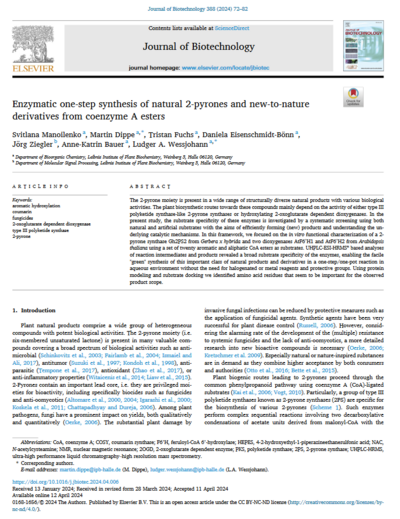2-Pyrones through biocatalysis.
2-pyrones are chemical ring structures that occur in many natural substances with various biological effects. Such effects range from antimicrobial and anti-parasitic to antioxidant and anti-inflammatory activity. 2-pyrone derivatives are also of interest as fungicides - such as the fungicidal compounds gerberin and para-sorboside from the ornamental plant Gerbera (Gerbera x hybrida). However, both the isolation of 2-pyrones from natural sources is difficult and the multi-step chemical synthesis requires organic solvents and often also halogenated reagents.
Scientists at the IPB are therefore investigating how natural and novel 2-pyrones can be produced more easily and sustainably. In their latest study, they explored the catalytic flexibility of enzymes that could be suitable for the biocatalysis of 2-pyrones. They tested recombinantly produced plant enzymes in vitro with twenty acyl-CoA thioesters as potential substrates. They could observe that a 2-pyron synthase from Gerbera, Gh2PS2, converted a broad spectrum of aliphatic and aromatic acyl-CoA substrates, but preferentially accepted planar compounds with flexible side chains rather than stiffer, unsaturated structures.
Feruloyl-CoA and homoferuloyl-CoA were successfully identified as substrates for the feruloyl-CoA 6'-hydroxylases 1 and 2 from Arabidopsis thaliana, whereby the non-native homoferuloyl substrate is of particular interest as it leads to the new-to-nature product homoscopoletin. Enzymatic access to such derivatives of natural products is very attractive, as these products could have more desirable properties or activity.
Through homology modelling of the enzyme structure and substrate docking experiments in silico, the scientists were able to identify amino acid residues that could be responsible for the substrate selectivity in the enzymes studied. Based on these findings, they discuss possible modifications to direct substrate specificity and selectivity towards desired products.
Finally, in an exemplary cascade reaction using Gh2PS2, the scientists demonstrated the successful production of a 2-pyrone with high purity on a preparative scale. The possibility of producing 2-pyrones biocatalytically in aqueous solution and in simple one-pot or cascade reactions is a promising way to obtaining complex and novel lead structures in an efficient and environmentally friendly way.
Original publication: Svitlana Manoilenko, Martin Dippe, Tristan Fuchs, Daniela Eisenschmidt-Bönn, Jörg Ziegler, Anne-Katrin Bauer, Ludger A. Wessjohann. 2024. Enzymatic one-step synthesis of natural 2-pyrones and new-to-nature derivatives from coenzyme A esters, Journal of Biotechnology, Volume 388, Pages 72-82, DOI: 10.1016/j.jbiotec.2024.04.006.


